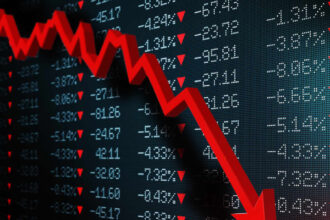People shop at an Apple store in Annapolis, Maryland, in February.
Jim Watson/Getty Images
Apple
and the rest of Big Tech have helped push the Nasdaq-100 into a new bull market, prompting concern that the rally is overdone. But there is a case to be made for further gains.
Apple (AAPL) stock is up about 30% from a low point hit in early January. That has helped the Nasdaq-100 Index, which tracks about 100 of the nonfinancial companies with the biggest market capitalizations on the tech-heavy Nasdaq exchange, to gain about 23% from its December low point.
Any gain of 20% or more from a low puts an index into bull-market territory.
Falling yields for long-dated bonds have been behind the gains in recent weeks. Lower yields make future profits more valuable — and many fast-growing tech companies are valued on the basis that the majority of their profits will roll in many years in the future.
Given the gains, some are warning that tech stocks look more like sells, not buys.
First off, they argue, the Nasdaq-100 hasn’t yet reached the 13,500 level where sellers came in in August, knocking the index lower. It is currently hovering just over 13,000.
It could easily lose steam before it surpasses 13,500 if the Federal Reserve has reason to keep rates higher for longer than the market currently anticipates.
The other red flag is that a lot of stocks on the index haven’t contributed much to the index’s gain. Apple, Meta Platforms (META),
Tesla
(TSLA) and
Nvidia
(NVDA) are leading the way. All of those names except for Apple are up between 60% and about 90% so far this year.
Those companies’ aggregate market value of about $4.4 trillion represents almost a third of the total for the entire Nasdaq-100, according to FactSet data. The Nasdaq-100 is market-cap weighted, which means its movements are influenced more by the movements of stocks with larger market values.
Given that the average stock on the index hasn’t pulled its weight so well, the index’s performance would likely weaken significantly if the big names falter.
And still, tech isn’t doomed.
First off, the Nasdaq-100 is increasing its chances at breaking above that key level. It already broke above the 12,500 level, roughly where sellers had knocked it lower many times in the past several months. The index is in the midst of breaking out of a larger downtrend, wrote Rich Ross, Evercore’s head of technical analysis.
Maybe the Big Tech names can keep the index afloat. Other names could also join the party.
That’s partly because interest rates may well remain below their highs. If so, tech valuations—stock prices as multiples of the per-share earnings expected over the near term—can remain stable.
The Invesco QQQ exchange-traded fund (QQQ), which tracks the Nasdaq-100, is trading at an aggregate 24.6 times forward earnings, up from just over 20 times at the end of last year.
But the ETF’s PEG ratio—a measure that divides the price/earnings multiple by the rate of earnings growth so that the valuation can take into account how fast profits are growing—isn’t that high. Lower PEG ratios are better, indicating that investors are paying less for more EPS growth.
Given that the fund is expected to achieve 13% annual EPS growth for the next three years, according to FactSet, the PEG ratio is about 1.8 times. That isn’t bad compared with the
S&P 500’s
2.2 times.
Assuming tech earnings multiples are fair around current levels, earnings growth could bring the stocks higher over time. “Long big tech,” is a good trade assuming rates don’t skyrocket from here, wrote strategists at
Bank of America.
Tech stocks may need to take a breather at some point soon, but buying a little and holding them for a year or more isn’t a terrible idea.
Write to Jacob Sonenshine at [email protected]
Read the full article here










